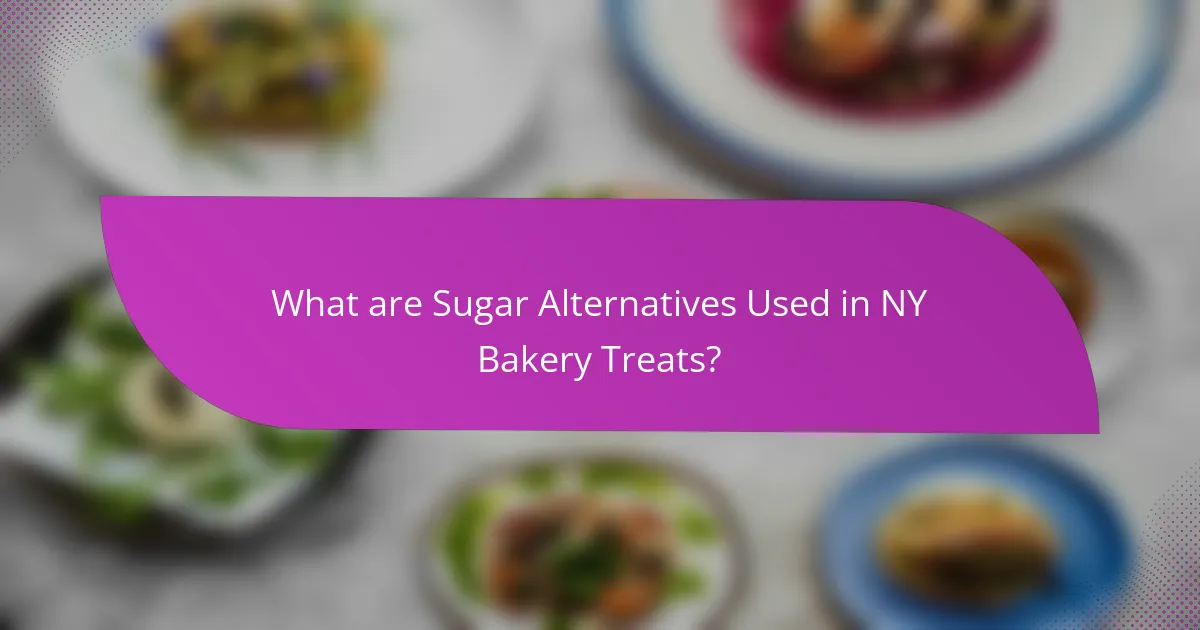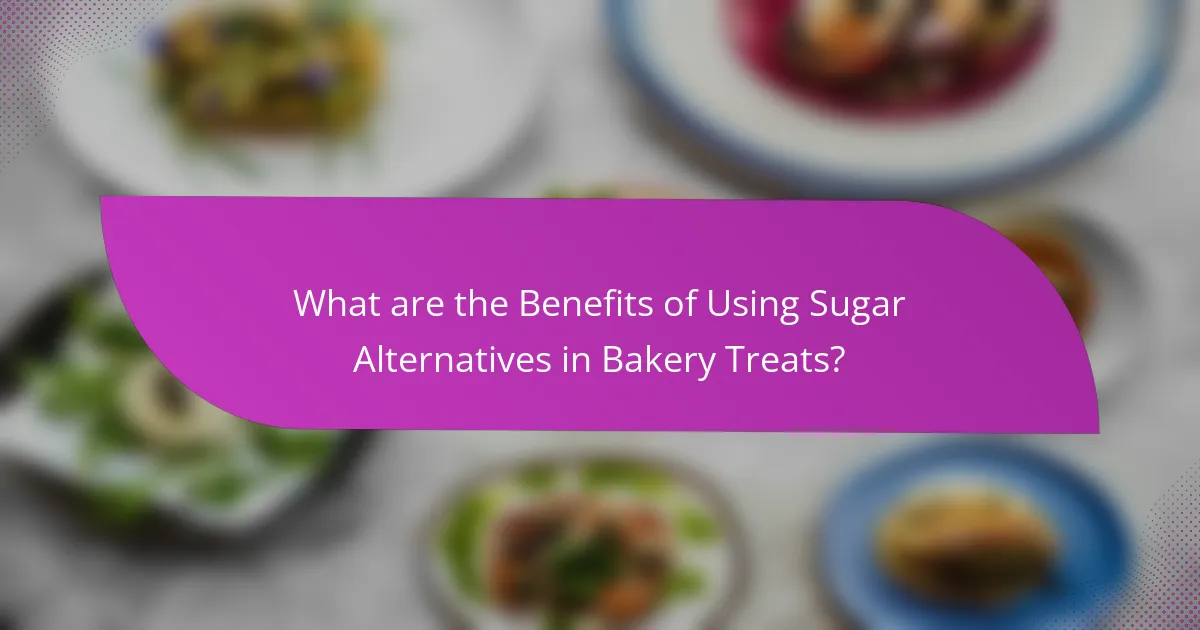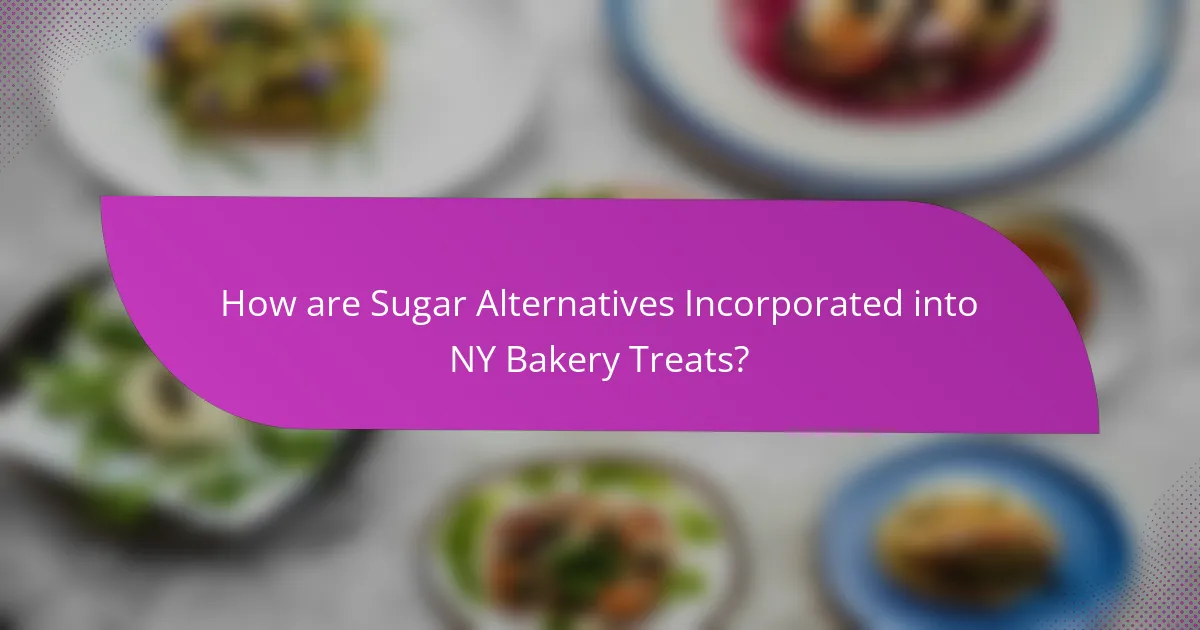Sugar alternatives, such as stevia, erythritol, and agave syrup, are increasingly used in New York bakery treats to provide healthier options for consumers. Stevia is a natural sweetener derived from the Stevia rebaudiana plant, while erythritol is a low-calorie sugar alcohol, and agave syrup is a sweetener from the agave plant. These alternatives are chosen for their lower glycemic index and potential health benefits, making them suitable for those managing weight or diabetes. The use of these sweeteners allows bakeries to create low-sugar or sugar-free desserts while maintaining desirable flavor and texture, catering to the growing demand for healthier baked goods.

What are Sugar Alternatives Used in NY Bakery Treats?
Common sugar alternatives used in NY bakery treats include stevia, erythritol, and agave syrup. Stevia is a natural sweetener derived from the leaves of the Stevia rebaudiana plant. Erythritol is a sugar alcohol that has fewer calories than sugar. Agave syrup is a sweetener made from the agave plant and is often considered healthier than traditional sugars. These alternatives are chosen for their lower glycemic index and potential health benefits. Many bakeries incorporate these substitutes to cater to health-conscious consumers. Research indicates that these alternatives can effectively mimic the sweetness of sugar without the associated calories.
How do Sugar Alternatives differ from Traditional Sugar?
Sugar alternatives differ from traditional sugar primarily in their chemical composition and caloric content. Traditional sugar, or sucrose, is a natural carbohydrate that provides energy but can lead to weight gain and other health issues when consumed in excess. In contrast, sugar alternatives, such as stevia or erythritol, often have fewer calories or no calories at all. For instance, stevia is derived from the leaves of the Stevia rebaudiana plant and is about 50 to 300 times sweeter than sugar without the calories. Erythritol, a sugar alcohol, contains only 0.24 calories per gram compared to sugar’s 4 calories per gram. Additionally, sugar alternatives can have different impacts on blood sugar levels. Traditional sugar causes rapid spikes in blood glucose, while many alternatives have minimal effects, making them suitable for diabetics. These differences highlight the varying health implications and applications of sugar alternatives in baking and cooking.
What are the key characteristics of Sugar Alternatives?
Sugar alternatives are substances used to sweeten foods without the calories of traditional sugar. They include natural and artificial options. Common natural alternatives are stevia and monk fruit. Artificial options include aspartame and sucralose. Sugar alternatives often have a lower glycemic index. This means they do not spike blood sugar levels as much as sugar does. Many sugar alternatives are significantly sweeter than sugar. They may also have fewer calories or none at all. Some sugar alternatives can impact taste and texture in baked goods.
Why are Sugar Alternatives gaining popularity in baking?
Sugar alternatives are gaining popularity in baking due to health concerns and dietary preferences. Many consumers seek to reduce sugar intake for weight management or health conditions like diabetes. Sugar alternatives provide sweetness with fewer calories, making them appealing for healthier recipes. Additionally, they often have a lower glycemic index, which helps maintain stable blood sugar levels. The rise of vegan and gluten-free diets has also increased interest in sugar alternatives, as they can cater to diverse dietary needs. According to a report by Grand View Research, the global sugar substitute market is projected to reach $23.6 billion by 2025, indicating strong consumer demand. This trend reflects a broader shift towards healthier eating habits in the baking industry.
What types of Sugar Alternatives are commonly used in NY Bakeries?
Common sugar alternatives used in NY bakeries include agave nectar, stevia, and coconut sugar. Agave nectar is derived from the agave plant and is sweeter than sugar. Stevia is a natural sweetener extracted from the leaves of the stevia plant. Coconut sugar is made from the sap of coconut palm and has a lower glycemic index. These alternatives are popular for their perceived health benefits. Many bakeries choose them to cater to health-conscious customers. The use of these alternatives aligns with trends in healthier eating.
What are the most popular natural Sugar Alternatives?
The most popular natural sugar alternatives include stevia, monk fruit, honey, and maple syrup. Stevia is derived from the leaves of the Stevia rebaudiana plant and is known for its zero-calorie content. Monk fruit sweetener comes from monk fruit and is also calorie-free. Honey is a natural sweetener with various health benefits, including antioxidants. Maple syrup is made from the sap of sugar maple trees and contains minerals like manganese and zinc. These alternatives are favored for their natural origins and potential health benefits compared to refined sugars.
How do artificial Sugar Alternatives compare to natural ones?
Artificial sugar alternatives are synthetically produced sweeteners, while natural ones are derived from plants. Artificial sweeteners, like aspartame and sucralose, often contain zero calories. In contrast, natural sweeteners, such as honey and agave, have caloric content.
Artificial alternatives are significantly sweeter than sugar, requiring smaller quantities for the same sweetness level. This can lead to lower overall calorie intake when used in moderation. However, some studies suggest that artificial sweeteners may affect gut health and appetite regulation.
Natural sweeteners provide additional nutrients and antioxidants, which artificial options lack. For instance, honey contains vitamins and minerals beneficial to health.
Consumer preferences often lean towards natural alternatives due to perceived health benefits and fewer synthetic ingredients. However, artificial sweeteners are favored for their calorie-free nature and longer shelf life.
In summary, artificial sugar alternatives offer low-calorie options but may lack nutritional benefits, while natural sweeteners provide added nutrients but contain calories.

What are the Benefits of Using Sugar Alternatives in Bakery Treats?
Using sugar alternatives in bakery treats offers several benefits. These alternatives can reduce overall calorie content. For example, stevia and erythritol have fewer calories than traditional sugar. This can help with weight management and reduce the risk of obesity. Sugar alternatives also have a lower glycemic index. This means they cause a slower rise in blood sugar levels. Consequently, they can be beneficial for individuals with diabetes. Additionally, some sugar alternatives provide added health benefits. For instance, certain sweeteners contain antioxidants. These can contribute to overall health improvement. Lastly, using sugar alternatives can enhance flavor profiles. They can add unique tastes that traditional sugar may not provide.
How do Sugar Alternatives impact health and nutrition?
Sugar alternatives can significantly impact health and nutrition by providing lower-calorie options for sweetening foods. These alternatives, such as stevia and erythritol, have little to no calories compared to traditional sugar. This can help reduce overall caloric intake, which may aid in weight management. Additionally, some sugar alternatives do not cause spikes in blood sugar levels, making them suitable for individuals with diabetes. Research indicates that certain sugar substitutes can promote dental health by not contributing to tooth decay. However, some sugar alternatives may cause digestive issues in sensitive individuals. Overall, the impact of sugar alternatives varies based on individual health conditions and consumption levels.
What are the potential health benefits of using Sugar Alternatives?
Sugar alternatives can provide several health benefits. They often contain fewer calories than regular sugar. This can assist in weight management. Many sugar alternatives do not raise blood sugar levels. This makes them suitable for diabetics. Some alternatives, like stevia, are derived from natural sources. These can offer a sweet taste without the calories. Certain sugar substitutes may also promote dental health. They do not contribute to tooth decay like regular sugar does. Research indicates that using sugar alternatives can reduce overall sugar consumption. Lower sugar intake is associated with a decreased risk of chronic diseases.
How do Sugar Alternatives affect calorie content in baked goods?
Sugar alternatives reduce calorie content in baked goods. Many sugar substitutes, like stevia or erythritol, contain fewer calories than regular sugar. For instance, stevia has zero calories per serving. Erythritol has about 0.24 calories per gram, compared to sugar’s 4 calories per gram. This significant difference allows bakers to create lower-calorie products. Additionally, using sugar alternatives can maintain sweetness without adding excess calories. Studies show that baked goods made with these substitutes can have 30-50% fewer calories. This makes them appealing for health-conscious consumers. Thus, sugar alternatives effectively lower the overall calorie content in baked goods.
What effects do Sugar Alternatives have on taste and texture?
Sugar alternatives can significantly affect taste and texture in baked goods. They often provide sweetness without the calories of sugar. Some alternatives, like stevia, may have a bitter aftertaste. Others, such as erythritol, mimic the texture of sugar closely. The texture can vary depending on the alternative used. For example, some sugar substitutes can lead to a drier product. In contrast, others may retain moisture better than traditional sugar. The choice of sugar alternative can also influence browning and caramelization during baking. Overall, the specific effects depend on the type of sugar alternative and its properties.
How do different Sugar Alternatives influence the flavor profile?
Different sugar alternatives can significantly influence the flavor profile of baked goods. For instance, stevia has a distinct sweetness that can sometimes impart a slight bitterness. Erythritol, on the other hand, tends to have a clean, sweet taste without aftertaste, making it popular in baking. Agave nectar offers a mild flavor with a hint of caramel, which can complement certain recipes. Coconut sugar brings a rich, molasses-like flavor that enhances depth. Additionally, monk fruit sweetener provides a sweet taste without calories, often with minimal impact on flavor. Each alternative not only sweetens but also interacts with other ingredients, affecting overall taste and texture.
What impact do Sugar Alternatives have on the texture of baked goods?
Sugar alternatives can significantly alter the texture of baked goods. They often lead to a denser product compared to traditional sugars. This is because sugar contributes to the aeration and structure in baking. Sugar alternatives may not provide the same moisture retention as sugar. For example, erythritol can create a drier texture due to its lower hygroscopicity. Additionally, some sugar alternatives can crystallize differently, affecting the final crumb structure. The specific impact varies depending on the type of alternative used. For instance, stevia may result in a lighter texture, while coconut sugar can add a coarser feel. Overall, the choice of sugar alternative is crucial for achieving the desired texture in baked goods.

How are Sugar Alternatives Incorporated into NY Bakery Treats?
Sugar alternatives are incorporated into NY bakery treats primarily as substitutes for traditional sugar. These alternatives include stevia, erythritol, and agave syrup. Bakers use these sweeteners to reduce calorie content and cater to health-conscious consumers. Recipes are often adjusted to maintain flavor and texture. For example, stevia is much sweeter than sugar, so smaller amounts are used. Erythritol adds bulk, which helps in achieving the desired consistency. Many NY bakeries also promote these treats as low-sugar or sugar-free options. This trend aligns with increasing consumer demand for healthier dessert choices.
What are the best practices for using Sugar Alternatives in recipes?
Use sugar alternatives in recipes by understanding their unique properties. Each alternative has different sweetness levels and may affect texture. Adjust the quantity based on the specific alternative’s sweetness compared to sugar. Some alternatives, like stevia, are much sweeter, requiring less. Others, like erythritol, can be used in equal amounts. Consider the moisture content; some alternatives may require additional liquid. Baking times may also vary, so monitor closely. Lastly, taste as you go to ensure the desired flavor profile.
How can bakers adjust traditional recipes to include Sugar Alternatives?
Bakers can adjust traditional recipes by substituting sugar with sugar alternatives in appropriate ratios. Many sugar alternatives are sweeter than sugar, so bakers should use less of them. For instance, stevia is about 200 to 300 times sweeter than sugar. This means bakers can use a small amount to achieve the desired sweetness.
Additionally, bakers should consider the moisture content of the alternatives. Some sugar substitutes, like honey or agave syrup, add liquid to the recipe. This may require reducing other liquid ingredients to maintain the right consistency.
Bakers also need to account for texture changes. Sugar contributes to the structure and mouthfeel of baked goods. Alternatives may not provide the same texture, so adjustments in baking time or temperature might be necessary.
Finally, bakers should test recipes to ensure the final product meets their taste and texture standards. Research shows that successful substitutions often require experimentation and adjustments to achieve optimal results.
What are common mistakes to avoid when using Sugar Alternatives?
Common mistakes to avoid when using sugar alternatives include assuming all substitutes are calorie-free. Many sugar alternatives have calories, which can affect overall intake. Another mistake is using the wrong type of alternative for specific recipes. Some alternatives do not behave like sugar in baking. Not adjusting measurements is also a common error. Sugar alternatives often require different quantities than regular sugar. Failing to consider aftertaste is another mistake. Some alternatives can have a bitter or metallic taste. Lastly, neglecting to check for digestive effects can lead to discomfort. Certain sugar alternatives can cause gastrointestinal issues in some individuals.
What are some popular NY Bakery Treats that use Sugar Alternatives?
Popular NY bakery treats that use sugar alternatives include almond flour brownies, avocado chocolate mousse, and coconut macaroons. Almond flour brownies often utilize erythritol or stevia as a sweetener. Avocado chocolate mousse achieves sweetness with agave nectar or monk fruit. Coconut macaroons can be made with honey or maple syrup instead of refined sugar. These alternatives cater to health-conscious consumers and those with dietary restrictions. Many bakeries in New York have embraced these options to appeal to a wider audience.
Which desserts have successfully integrated Sugar Alternatives?
Desserts that have successfully integrated sugar alternatives include sugar-free brownies, keto cheesecakes, and almond flour cookies. These desserts utilize sweeteners like stevia, erythritol, and monk fruit. Sugar-free brownies often maintain moisture and richness through the use of these alternatives. Keto cheesecakes leverage low-carb sweeteners to achieve a creamy texture without added sugars. Almond flour cookies provide a gluten-free option while incorporating sweeteners that do not spike blood sugar levels. These adaptations cater to health-conscious consumers seeking lower-calorie desserts.
How do customers respond to Sugar Alternative-based treats?
Customers generally respond positively to sugar alternative-based treats. Many appreciate the lower calorie content and potential health benefits. Taste preferences vary, with some finding the flavors satisfactory. Others may perceive a difference compared to traditional sugar treats. A survey indicated that 70% of consumers enjoy sugar alternatives for guilt-free indulgence. Additionally, customers often express interest in healthier options. Repeat purchases suggest a growing acceptance of these products. Overall, the response reflects a shift towards health-conscious eating habits.
What tips can bakers follow when choosing Sugar Alternatives?
Bakers should consider the sweetness level of sugar alternatives. Different alternatives have varying degrees of sweetness. For example, stevia is much sweeter than sugar, while coconut sugar is less sweet. Bakers must also evaluate the texture that each alternative provides. Some alternatives may not mimic the moisture and bulk of sugar. Additionally, bakers should check for any aftertaste associated with certain sugar substitutes. For instance, some people find that artificial sweeteners leave a bitter aftertaste. It is essential to consider the health aspects of sugar alternatives. Some alternatives are low-calorie, while others may contain more calories than sugar. Lastly, bakers should experiment with combinations of sugar alternatives to achieve the desired flavor and texture in their baked goods. This trial-and-error approach can lead to the best results in recipes.
The main entity of the article is sugar alternatives used in NY bakery treats. The article provides an overview of common sugar substitutes such as stevia, erythritol, and agave syrup, highlighting their health benefits, including lower calorie content and reduced glycemic index. It discusses how these alternatives differ from traditional sugar in terms of chemical composition and caloric impact, along with their effects on taste and texture in baked goods. Additionally, the article addresses the growing popularity of sugar alternatives in baking, the best practices for their use, and how they cater to health-conscious consumers.




